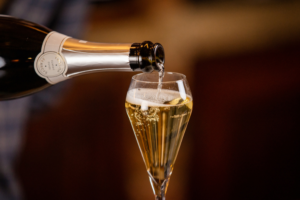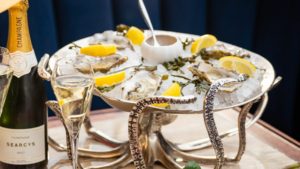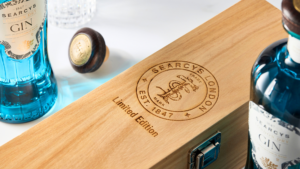-
World Champagne Day: The Science of Champagne
27 October 2023Champagne is renowned for its bubbly charm and unique flavours, often linked to special occasions and extravagance. However, beneath its glamorous facade, lies a captivating realm of scientific intricacies that influence the enjoyment of this iconic drink. Earlier this year, Searcys was proud to welcome Professor Barry Smith at the Royal Institution, for a sold-out talk delving into the scientific aspects of Champagne. The discussion covered its impact on our senses, traditional food pairings, and the mysterious notion of “minerality”.
In celebration of World Champagne Day, we are delighted to share a snippet of the fascinating science of Champagne, as explained by Professor Barry Smith
The Sensory Symphony of Champagne:


Champagne is unique among most drinks in how it engages all our senses. When you take a sip, it’s not just your taste buds that come alive. Champagne activates various sensory receptors:
Sight: The delicate bubbles, dancing in the glass, create an enticing visual display.
Hearing: Often dubbed the “most sonic drink,” the popping of the cork and the sound of the fizz contribute to the overall experience.
Taste: The interplay of sweet, sour, and bitter notes tantalizes our taste buds.
Smell: The aroma of Champagne plays a significant role in shaping our perception of its flavours.
Feel: The release of CO2 bubbles triggers the trigeminal nerve, located between the eyes, nose, and mouth, creating that delightful tingle in the nose.
Essentially, it’s the way that Champagne captivates every faculty which gives it the distinct reputation that sets it apart from all other wines.
The Chemistry of Food Pairing:


The classic pairing of Champagne and oysters is more than just tradition; it’s rooted in chemical affinity. The flavours of Champagne interact with the umami content such as glutamic acid and ribonucleotides in foods like oysters, scallops, and cheeses, enhancing the overall taste experience. Umami, the fifth basic taste, is known for its savoury, mouth-watering quality, which is what causes it to taste so delicious.
The meaning of “Minerality”:


Have you ever heard the term “minerality” when discussing Champagne? It refers to a mysterious quality often associated with certain wines, especially Chablis. Although frequently mentioned, defining “minerality” remains elusive, with questions remaining as to what it means or what real impact it has, and there is little agreement among wine tasters about its precise nature. Some suggest it’s linked to saltiness or mouthfeel, but the concept remains open to interpretation, and potentially reductive when trying to adequately describe the taste and nature of a sparkling wine.
The Science of Champagne and Aging:


Champagne houses employ an artful process of blending up to 350 different wines to maintain consistent flavour profiles each year. Additionally, ageing Champagne on the lees (yeast sediments) enhances its umami content, making it an excellent companion for a wide range of dishes, textures and flavours.
This lesson on the Science of Champagne offers a glimpse into the complexities behind this iconic tipple. So, the next time you raise a glass of Searcys Champagne, take a moment to savour not just the effervescence but also the scientific wonders that make bubbly truly exceptional.
Find out for yourself and enjoy World Champagne Day on 27th October at one of Searcys’ restaurants and Champagne Bars. Discover how to celebrate with Searcys here.
Thank you to Professor Barry Smith and The Royal Institution for their contribution.
- ABOUT SEARCYS
- About Searcys
- News
- All News
- Introducing Searcys New English Sparkling Wine
- Unveiling Searcys Newest Events Venue, Surveyors House at RICS
- The Ultimate Venues for your Summer Soirée with Searcys
- Earth Day at Searcys
- Introducing Horizon 22: Searcys Newest Events Venue
- Dining at The Searcys Bubbly Show
- Searcys Ideas Forum at 116 Pall Mall
- 30 Euston Square Hosts Influential Planet Peach Sustainability Summit
- International Women’s Day 2024: The Women of Champagne
- Searcys Raises over £10,000 for Charity
- A Year in Searcys
- Searcys Partner with Richard Corrigan to Relaunch The Portrait Restaurant at The National Portrait Gallery
- Thomas Piat Joins Searcys as Executive Chef Across Restaurant Estate
- Searcys wins Event Caterer of The Year
- Searcys and Benugo Partner with ALVA
- RECENT PRESS
- Harpers Bazaar: London’s best pre-theatre menus
- Evening Standard: Searcys Bubbly Show at {10-11} Carlton House Terrace
- Tatler: The most regal teas in London to celebrate the Coronation in style
- Tatler: Think you really know your champagne?
- Royal Central: Searcys princess cake
- The Independent: 11 of the best bars around the world
- London Economic: Searcys celebrates 175th year
- Restaurants and Bars
- Event Venues
- EVENT SPACES
- All Locations
- {10-11} Carlton House Terrace
- 30 Euston Square
- 41 Portland Place
- 116 Pall Mall
- Apothecaries’ Hall
- Barber-Surgeons Hall
- Battersea Power Station
- Brigade Bar and Kitchen
- Carpenters’ Hall
- Church House
- Horizon 22
- IET London: Savoy Place
- National Army Museum
- No. 11 Cavendish Square
- One Moorgate Place
- Saddlers’ Hall
- EVENT SPACES
- Event Types
- Made For Events
- Let Us Find Your Venue
- What’s On
- Contact Us
- ABOUT SEARCYS
- About Searcys
- News
- All News
- Introducing Searcys New English Sparkling Wine
- Unveiling Searcys Newest Events Venue, Surveyors House at RICS
- The Ultimate Venues for your Summer Soirée with Searcys
- Earth Day at Searcys
- Introducing Horizon 22: Searcys Newest Events Venue
- Dining at The Searcys Bubbly Show
- Searcys Ideas Forum at 116 Pall Mall
- 30 Euston Square Hosts Influential Planet Peach Sustainability Summit
- International Women’s Day 2024: The Women of Champagne
- Searcys Raises over £10,000 for Charity
- A Year in Searcys
- Searcys Partner with Richard Corrigan to Relaunch The Portrait Restaurant at The National Portrait Gallery
- Thomas Piat Joins Searcys as Executive Chef Across Restaurant Estate
- Searcys wins Event Caterer of The Year
- Searcys and Benugo Partner with ALVA
- RECENT PRESS
- Harpers Bazaar: London’s best pre-theatre menus
- Evening Standard: Searcys Bubbly Show at {10-11} Carlton House Terrace
- Tatler: The most regal teas in London to celebrate the Coronation in style
- Tatler: Think you really know your champagne?
- Royal Central: Searcys princess cake
- The Independent: 11 of the best bars around the world
- London Economic: Searcys celebrates 175th year
- Restaurants and Bars
- Event Venues
- EVENT SPACES
- All Locations
- {10-11} Carlton House Terrace
- 30 Euston Square
- 41 Portland Place
- 116 Pall Mall
- Apothecaries’ Hall
- Barber-Surgeons Hall
- Battersea Power Station
- Brigade Bar and Kitchen
- Carpenters’ Hall
- Church House
- Horizon 22
- IET London: Savoy Place
- National Army Museum
- No. 11 Cavendish Square
- One Moorgate Place
- Saddlers’ Hall
- EVENT SPACES
- Event Types
- Made For Events
- Let Us Find Your Venue
- What’s On
- Contact Us
Saved Venues0

